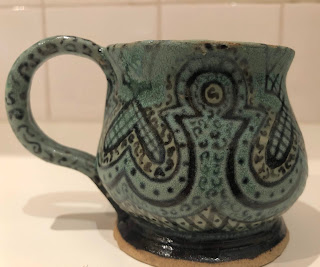(Japan and The Netherlands) A good 28 page article on the porcelain trade by the VOC from 1600 - 1660's. Discusses the introduction of Chinese porcelain via captured Portaguse ships in 1602 and 1604
(Iraq, Iran and Egypt) A section
on the Abbasiddian potters from a web based teaching course on islamic ceramics
hosted by the Ashmolean Museum. http://islamicceramics.ashmolean.org/Abbasid/pottery.htm
(Iraq, Iran and Egypt) A PDF
article on the Abbasid perception of Chinese Ceramics.
Hallet,
J. 2010 Pearl Cups like the Moon, The Abbasid perception of Chinese
Ceramics. Shipwrecked: Tang Treasures and Monsoon Winds.. eds
Krahl, R. Guy, J. Wilson, J.K. Raby, J. Arthur M. Sackler Gallery, Smithsonian
Institution, pp 75-81
(Iraq and Egypt) A great scientific paper PDF on the reciprocal influence of Tang China and Abbasid Iraq ceramics.
Wood, N., and Tite, M., (2009), ‘Blue and White – the Early Years : Tang China and Abbasid Iraq compared.’
Transfer : The Influence of China on World Ceramics. (Colloquies on Art
& Archaeology in Asia No. 24. Percival David Foundation of Chinese
Art. ed. Stacey Person, ed. London University, pp 21-45
(Iraq) A short
article on Basra's Potters and their developments
Attwood,
R. 2005 Basra's Inventive Potters. Archeology Reviews.
Vol 58, 2.
(Iraq, Iran, Egypt, China, Turkey) A PhD
thesis I'd really like to get my hands on, scientific analysis of the origins
of cobalt.
|
|||||
Wen, R.
2012. The cobalt blue pigment used on Islamic ceramics and
chinese blue-and-white porcelain. PhD Thesis, University of
Oxford.
(China) A nice summary of political China and some great post-period items. http://gotheborg.com/chronology/index-chronology.htm (Iran - Timurid) Golombek, L. Mason, R.B. Bailey, A. 1996 Tamerlane's tableware: A new approach to the chinoiserie ceramics of fifteenth-sixteenth century Iran. Mazda Publishers ISBN 10: 1568590431 (Iran - Safavid) Golombek, L. Mason, R.B. Bailey, A. 2013 Persian pottery in the first global age: The sizteenth and Seventeenth Centuries. Brill. ISBN 10: 9004260927 (Iran - Ayyubid) Milwright, M. 1999. Pottery in the written sources of the Ayyubid-Mamluk period (c. 567-923 / 1171-1517). Bulletin of the School of Oriental and African Studies, University of London. Vol 62, No 3. pp 504-518. | |||||















